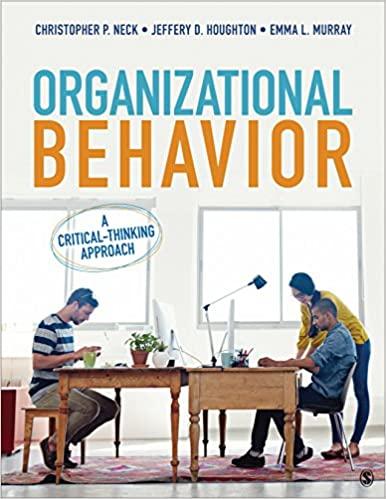According to CNN Money, barista carries the dubious dual distinction of being one of the nations most
Question:
According to CNN Money, barista carries the dubious dual distinction of being one of the nation’s most stressful jobs and among those with the lowest pay. Baristas face many challenges: not only do they have to deal with the physical demands of making and serving coffee, they also have the emotional stress of coping with early morning lines of impatient customers in a hurry. In a recent poll surveying coffee workers, 55 percent of respondents reported upper-body repetitive stress injuries, 37 percent complained of persistent sore muscles, 29 percent said they suffered from anxiety attacks, and 44 percent lamented high stress levels. Considering that the median pay of baristas is $20,300, is the stress really worth it? How might their employers help baristas cope?
Howard Shultz is CEO of Starbucks Coffee, which is worth about $72.4 billion at the time of this writing and is projected to grow. There are more than 21,000 stores in 65 countries with 191,000+ employees, the bulk of whom are serving up your morning joe. After slashing jobs and closing stores in 2009, Shultz and Starbucks are brewing up new business again. The company’s China/Asia Pacific business grew revenue at 85 percent year over year as reported at close of 2014.
When Starbucks was conceived by three friends on the Seattle waterfront in 1971, the number one principle of its mission statement was bold: “To provide a great work environment and treat each other with respect and dignity.” Forty-plus years later, Starbucks continues to provide an exception to CNN Money’s suggestion that the barista job is generally awful. The company frequently tops Fortune’s “100 Best Companies to Work For” list and has legions of fierce brand loyalists, many of them employees past and present. You can read employee testimonials on Glassdoor.com (“When I first started [with Starbucks] I had no intention of making a career out of Starbucks. Now, I have no intention of having a career without Starbucks”), plus numerous glowing blogs and the 2007 bestseller, How Starbucks Saved My Life: A Son of Privilege Learns to Live Like Everyone Else, by Michael Gates Gill.
Managers know that happy, healthy employees make for a better workforce, and a better workforce means a better experience for customers. To keep the money rolling in—while remaining true to its founding principles—
Starbucks has had to be proactive about battling the barista blues. In the late 1990s, after conducting its own internal studies, Starbucks enlisted the help of La Marzocco, the Italian maker of espresso machines. La Marzocco in turn reached out to an osteopath and a physical therapist for insight into the company’s concerns about the repetitive actions performed by the baristas. They found that lifting milk jugs and steaming milk, tamping, inserting and removing portafilters, and simply standing for long periods had serious health implications. The demands also placed a dampener on staff “happiness and effectiveness.” To combat the effects, Starbucks worked with La Marzocco to develop a number of new employee-friendly technologies, including the auto-dosing and tamping Swift grinder. Throughout the decades, Starbucks has continued to innovate and automate processes with its employees’ health and safety in mind.
In Peter Ubel’s article in Forbes, “Do Starbucks’ Employees Have More Emotional Intelligence Than Your Physician?” the author suggests that doctors have a lot to learn from Starbucks’ baristas in terms of managing stress and communicating with constituents. He points out that, unlike physicians, Starbucks’ employees are trained to be emotionally sensitive and intuitive and to act accordingly. In the “Latte Method,” they undergo rigorous training on how to recognize and respond to customer needs. When a customer is unhappy, the Latte Method suggests, “We Listen to the customer, Acknowledge their complaint, Take action by solving the problem, Thank them, and then Explain why the problem occurred.”
With a framework in place to manage customer anxiety, Starbucks also succeeds in soothing employees’ nerves by providing the employee a basis for managing customers that reduces the fear of the unknown. The framework also empowers the employee (gives them tools) to handle stressful customer situations.
Questions 1. Starbucks’ core agenda is to provide an excellent work environment and for employees to treat each other with respect and dignity. How were they able to make this happen?
2. Describe the “Latte Method.” How did it help grow Starbucks?
3. Employees say that they love Starbucks’ company culture, and Starbucks regularly tops Fortune’s “100 Best Companies to Work For.” How does Starbucks promote organizational commitment and job satisfaction?
Step by Step Answer:

Organizational Behavior A Critical Thinking Approach
ISBN: 9781506314402
1st Edition
Authors: Christopher P. Neck, Jeffery D. Houghton, Emma L. Murray





